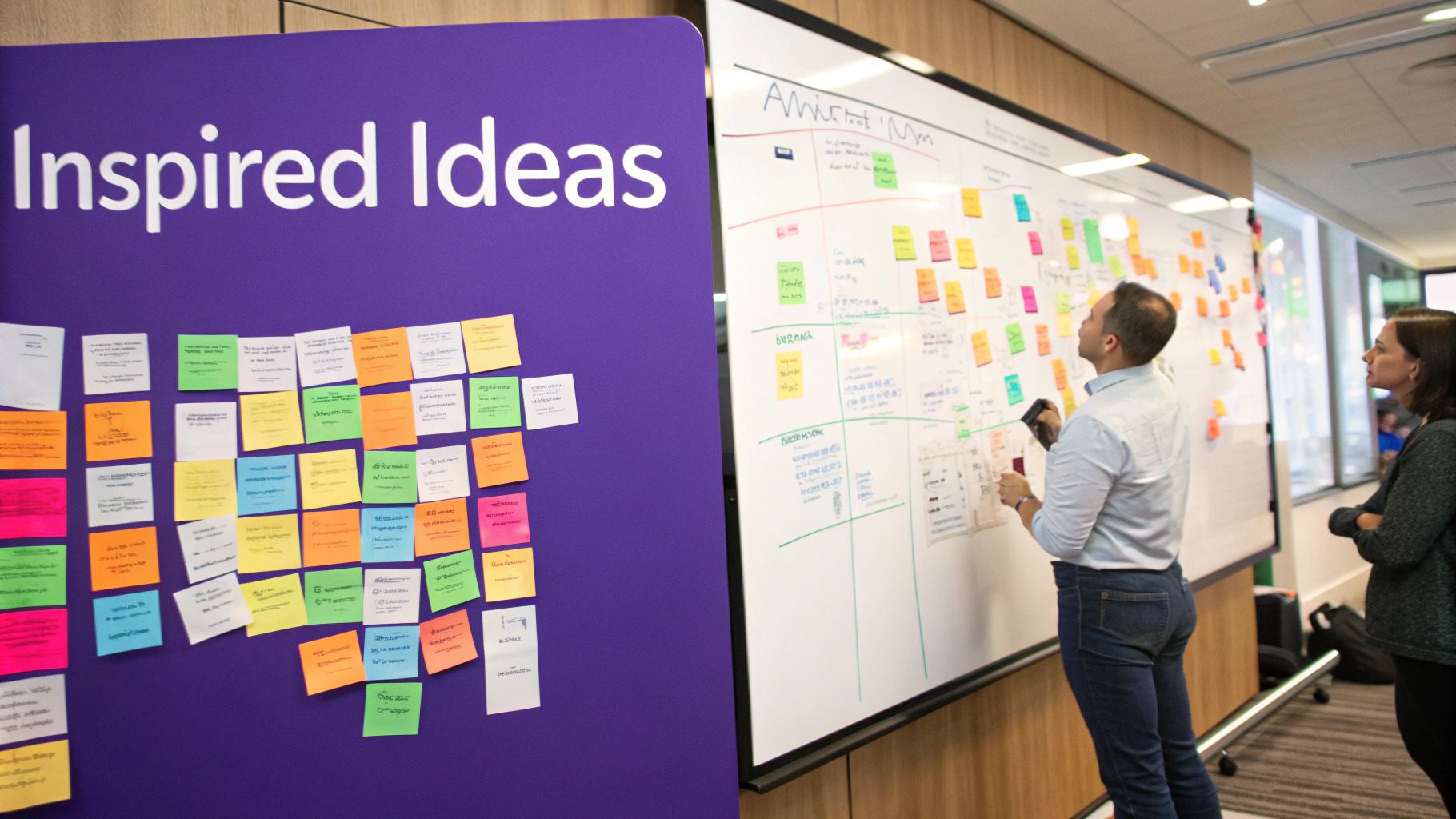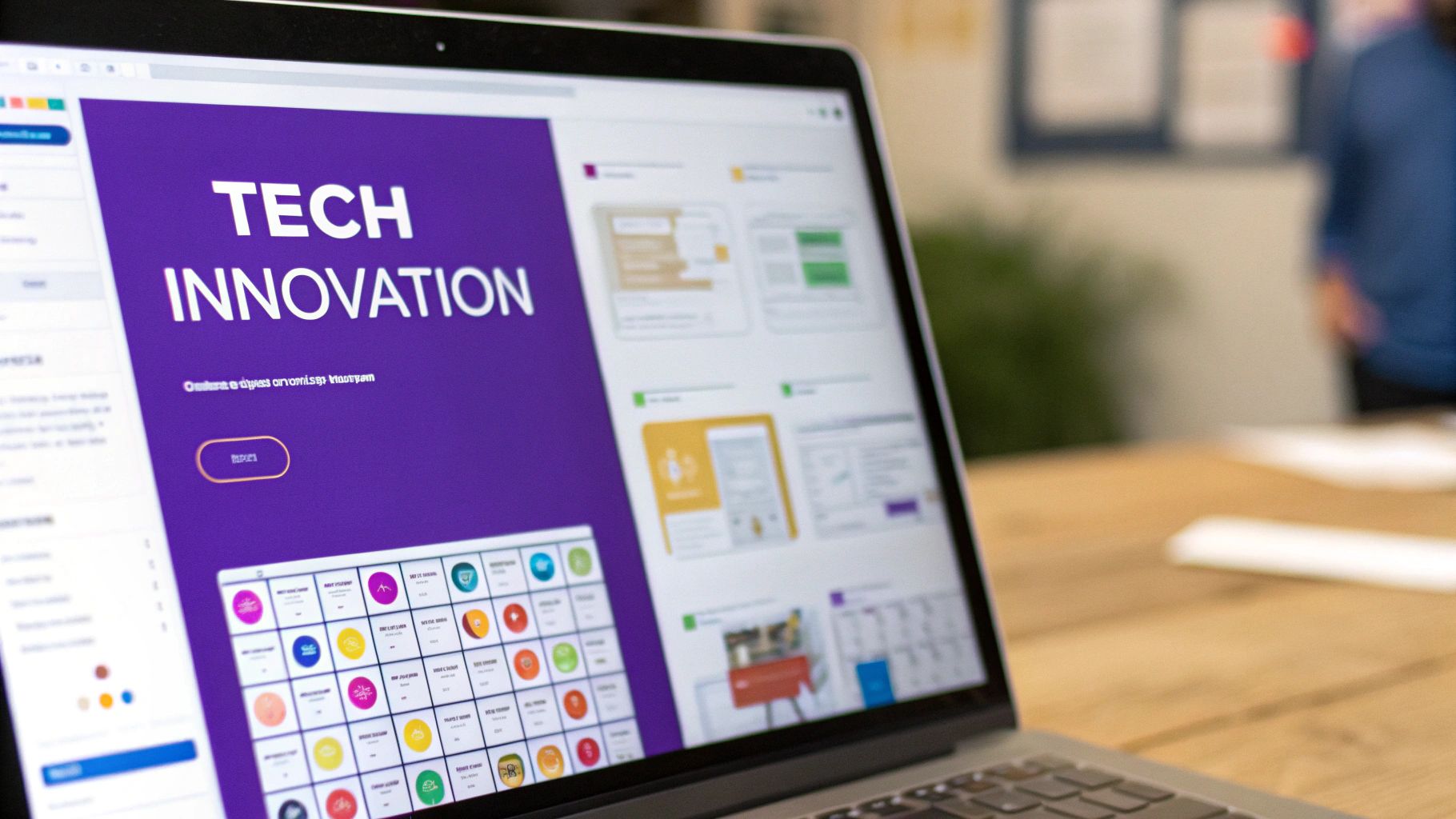The Evolution of Virtual Brainstorming in Modern Teams

Teams working across different locations are finding that virtual brainstorming has become essential for working together effectively. Digital platforms offer new ways to generate and share ideas that go beyond what's possible in traditional face-to-face meetings. Recent research shows that online collaboration tools actually help teams come up with more ideas than in-person sessions, while making it easier for everyone to participate.
Why Virtual Brainstorming Works Better
Digital brainstorming brings several key benefits that help teams collaborate more effectively:
- Equal Participation: Online tools make it comfortable for everyone to share ideas openly, which helps bring out thoughts from quieter team members who might not speak up in person.
- More Ideas Generated: Research from the University of Sydney found virtual sessions produced 75% more ideas than in-person meetings, largely because people felt more at ease sharing from their own space. Read the full research.
- Better Scheduling: Teams can meet more often and more easily since members can join from anywhere, leading to more frequent and focused sessions.
Proven Methods for Virtual Brainstorming
Making virtual brainstorming work takes more than just setting up a video call. Here are tested approaches that keep everyone engaged and productive:
- Mind Mapping: Using digital mind maps helps organize thoughts visually as they emerge, making it easy to see how different ideas connect.
- Written Ideas First: Having everyone write down their thoughts before sharing helps reduce social pressure and gets more people involved.
- Idea Grouping: After the session, organizing similar ideas together helps teams spot patterns and make better decisions about what to pursue.
When teams use these methods well, their virtual brainstorming sessions produce better results with more creative solutions. Real examples show that online collaboration, done right, helps teams tap into diverse perspectives across locations. This practical approach to sharing ideas sets up organizations for ongoing success as remote work continues to grow.
Making Virtual Brainstorming Better with AI
The way teams brainstorm online has changed a lot. It's no longer just about video calls and digital whiteboards. Today, artificial intelligence (AI) works alongside teams to help them develop creative ideas in new ways. When teams combine human creativity with AI tools, they can achieve better results.
How AI Helps Teams Brainstorm Online
AI adds several key features to virtual brainstorming. For example, some platforms provide real-time transcription and translation, which helps teams communicate across languages while keeping accurate records. AI can also automatically organize ideas into groups through idea clustering, making it easier for teams to spot important patterns and themes. This organization helps teams make better decisions when dealing with many ideas.
AI's Impact on Team Creativity
AI does more than just organize – it actively helps teams be more creative. Studies show that using AI in brainstorming can lead to a 50% increase in new ideas generated. AI suggests fresh perspectives and finds connections that people might miss. For example, Visily makes team collaboration smoother by letting people share ideas and give feedback quickly. This leads to 30% better communication between team members and 25% less confusion overall. Learn more about how AI helps teams brainstorm at this resource. These tools help teams overcome creative blocks and explore new directions.
Working with Both AI and Human Leaders
While AI tools are powerful, having skilled human leaders is still essential. Meeting facilitators play a key role in guiding sessions, getting everyone involved, and using AI tools effectively. They help define problems clearly, manage group dynamics, and turn ideas into action plans. The best results come when teams blend human skills with AI assistance. This partnership between people and technology is shaping how teams will brainstorm in the future. Teams that learn to use both elements well will get the most out of their creative sessions.
Mastering Virtual Brainstorming Facilitation

Running successful virtual brainstorming requires more than just good tools – it needs skilled guidance. A great facilitator can help a scattered online group generate amazing ideas together. Getting this right means understanding how people collaborate remotely and using methods that keep everyone focused and engaged.
Key Elements of Successful Virtual Facilitation
Leading an online brainstorming session is quite different from running an in-person meeting. You need to be good with digital tools while keeping people interacting and making progress. Here are the essential components:
- Clear Goals: Start by explaining exactly what you want to achieve in the virtual brainstorming session. What specific problem needs solving? What results are you looking for? Setting clear expectations helps everyone stay focused.
- Well-Planned Schedule: Create a detailed timeline showing what you'll cover and when. This roadmap keeps the group on track and makes sure you address everything important. A schedule is extra helpful online where distractions are common.
- Basic Rules: Set simple guidelines like muting when not talking and using chat for questions. These help avoid interruptions and keep conversations flowing smoothly.
Techniques for Managing Digital Group Dynamics
Getting a group spread across different locations to work well together takes specific skills. Try these proven approaches:
- Quick Warmups: Begin with a short activity to help people relax and connect. Something simple like sharing their best remote work tip can get everyone comfortable sharing ideas.
- Visual Tools: Use shared whiteboards or mind maps so people can see ideas come together. Many tools like Bulby have built-in features that make this easy.
- Active Inclusion: Make sure everyone gets chances to share, especially quieter participants. Methods like going around the group or writing ideas first help get input from all.
Maintaining Creative Momentum and Ensuring Actionable Outcomes
Keeping energy and ideas flowing in a virtual session takes planning. Here's what works:
- Timed Activities: Give each part of the process a specific time limit. This prevents things from dragging and keeps people focused.
- Short Breaks: Plan quick pauses to help prevent screen fatigue and keep minds fresh.
- Record and Sort Ideas: Use shared documents to capture every idea. After brainstorming, pick the best ones and make clear plans to act on them. This turns virtual brainstorming into real progress.
These facilitation methods help unlock your team's creative potential and make online brainstorming truly productive. Focus on creating a structured but welcoming space where everyone feels ready to share ideas. Tools like Bulby can help by providing one place for generating, organizing and developing ideas together.
Building an Inclusive Virtual Ideation Culture

Creating an open environment for virtual brainstorming takes more than just having good tools. Teams need a culture where everyone can contribute freely, no matter where they work from or what their background is. Key factors like time zones, cultural backgrounds, and communication preferences can heavily influence how people participate and share ideas.
Creating a Safe Space for Everyone to Contribute
Psychological safety is essential for good virtual brainstorming. When team members know they can share ideas without judgment, participation naturally increases. One simple way to encourage this is using anonymous submission features in tools like Bulby. Setting clear guidelines for respectful communication also helps create an environment where everyone's input is valued.
Working Across Different Communication Styles
Virtual teams often include people from many different cultures who communicate in different ways. Some people are very direct, while others prefer more subtle communication. Good facilitators recognize these differences and adjust their approach accordingly. While translation tools can help bridge language gaps, true cultural understanding goes deeper – it's about respecting different viewpoints and work approaches.
Practical Steps to Include Everyone
Here are proven ways to make virtual brainstorming more inclusive:
- Pre-session surveys: Get input from everyone before meetings, giving quiet team members a chance to share thoughts
- Multiple brainstorming methods: Use different techniques like mind maps and written exercises to match various thinking styles
- Flexible timing: Allow people to add ideas before and after live sessions to work around different schedules
- Smart scheduling: Pick meeting times that work reasonably well for all time zones, and rotate times to be fair
- Small group discussions: Use breakout rooms to create comfortable spaces where more people feel ready to share
Checking Progress on Inclusion
Track how well your inclusion efforts work by looking at who participates and gathering honest feedback about the process. Pay attention to whether you're getting ideas from everyone and use what you learn to keep improving. This helps create better brainstorming sessions that bring out more creative solutions from your whole team.
Measuring Success and Driving Continuous Improvement
Capturing and analyzing the results of virtual brainstorming requires careful attention. Merely counting total ideas isn't enough – we need to assess quality, implementation, and real business impact. Here's how to create an effective measurement framework.
Evaluating Virtual Brainstorming Session Outcomes
To properly gauge success, examine both the quantity and quality of ideas generated. Consider factors like:
- Originality and creativity of concepts
- Technical and financial feasibility
- Strategic fit with business goals
- Ratings from participants based on clear criteria
Organizing ideas into themes helps reveal patterns and priority areas. Project management tools can help track and categorize contributions effectively.
Tracking Idea Implementation and Measuring Long-Term Impact
The real value emerges when great ideas become reality. Key steps include:
- Assigning clear ownership and timelines
- Breaking ideas into actionable tasks
- Monitoring progress through completion
- Calculating return on investment (ROI)
This accountability demonstrates the concrete benefits of virtual brainstorming and builds support for future sessions.
Gathering Feedback and Identifying Improvement Opportunities
Regular input from participants guides program refinement. Collect feedback through:
- Post-session surveys
- Anonymous suggestion forms
- Team debrief discussions
Focus on practical issues like technical glitches, session timing and flow, and facilitation approaches. Use this input to strengthen future sessions.
Using Data to Refine Your Virtual Brainstorming Approach
Data from all these sources – outcomes, implementation tracking, and participant feedback – reveals what's working and what needs adjustment. Look for:
- Trends in idea quality and quantity
- Common technical or process issues
- Most/least effective brainstorming techniques
- Implementation success rates
This creates a cycle of continuous improvement, making each virtual brainstorming session more productive than the last.
Selecting and Optimizing Virtual Brainstorming Tools
Success in virtual brainstorming comes down to picking and properly using the right tools for your team. Just like a carpenter needs the right tools for each job, teams need appropriate digital tools to brainstorm effectively online.
Key Features to Consider in Virtual Brainstorming Tools
When choosing a virtual brainstorming platform for your team, focus on these key capabilities:
- Real-Time Collaboration: Pick tools that enable everyone to edit and contribute ideas at the same time, like working together on a shared digital whiteboard.
- Built-in Templates: Look for platforms with ready-to-use templates for common techniques like mind mapping and SWOT analysis. This saves time and provides helpful structure.
- Idea Organization: Good platforms help sort and prioritize the many ideas generated during sessions through features like tagging, voting, and visual grouping.
- Integration Options: Choose tools that work smoothly with your existing project management and communication platforms to maintain efficient workflows.
- Easy to Use: Select platforms that team members can quickly learn and feel comfortable using, regardless of their tech experience level.
Comparing Popular Virtual Brainstorming Platforms
Here's how some leading options compare:
| Feature | Bulby | Miro | Mural |
|---|---|---|---|
| Real-time Collab | Yes | Yes | Yes |
| Templates | AI-powered, Research-backed exercises | Basic templates available | Customizable templates |
| Idea Organization | AI-assisted grouping & prioritization | Manual tagging and organization | Visual clustering and grouping |
| Integrations | Project management tools | Various integrations | Project management and design tools |
| User-friendliness | Intuitive, guided process | Can be complex for new users | Can have a learning curve |
Optimizing Your Chosen Virtual Brainstorming Tool
After selecting a tool, follow these best practices:
- Training: Give your team proper training on using the platform's features. This prevents frustration and helps everyone use it effectively.
- Clear Guidelines: Set specific rules for how to use the tool during sessions, like who takes notes and which templates to use.
- Review and Adjust: Ask for feedback regularly about how well the tool works for your team. Be ready to adjust your approach or try different platforms as needed.
By following these guidelines, you can make your virtual brainstorming sessions more productive and creative.
Boost your team's brainstorming power with Bulby's AI-powered platform, designed specifically for remote teams to generate and refine ideas effectively. Explore Bulby today!

